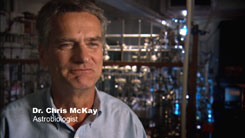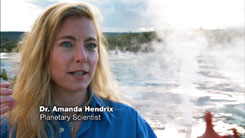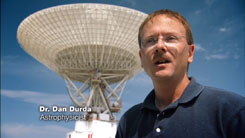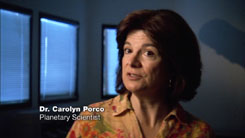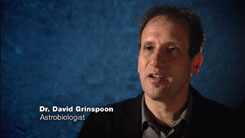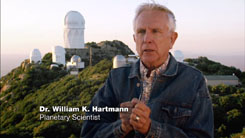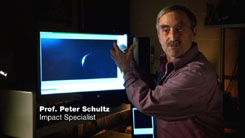Overall, this documentary is a fairly satisfying overview
of the variety of moons in our solar system - possibly the best episode
of the first season.
Drs. Chris McKay, Amanda Hendrix, Dan Durda, and Carolyn Porco
all give fascinating bits of information on various aspects of
specific moons, and hold viewer attention well. McKay even
explains and demonstrates his recreating of
tholins in the lab, just as they would be created on the cold outer moons,
and McKay's exuberance towards the process is infectious.
Other highlights include the geological contrast demonstrated here
between Ganymede and Callisto, the very detailed graphic trajectory of Cruithne
that aptly shows why it's only considered an "almost second moon" of Earth,
and the various New Millennium discoveries of the Cassini probe
as it investigates Saturn's rings and moons.
The Theia Impact theory of the creation of Earth's moon is also
detailed, including corroborating experiments, but somehow this turned
out to be less captivating than much of the other material.
A much better presentation can be found in the season 4 episode of
"The Universe" called
"The Day the Moon Was Gone",
in which Dr. William Hartmann gives a much better interview,
and the theory is fleshed out much more fully.
Once again, the narration is a bit stuck on trying to be too spellbound
with simple concepts. It's important to recap the accretion concept
early in this episode in order to understand the examples and specifics
that the scientists discuss later on, but since accretion was covered
extensively in previous episodes, the narration's
"oh, this is so awesome, it must be the answer to everything" style
is a bit over the top. Our minds are inquiring, not supplicating!
I often find myself wishing the narration would get out of the way
and let the scientists take over more on this series. At least, in this episode,
it does feel like that happens quite often, and our tour of the
solar system's moons feels quite rich and full by the time it is all over.
Definitely one of the best episodes in this series.
Moons detailed include:
- geological contrast of Ganymede and Callisto
- Io
- Europa
- Saturn's rings (technically billions of moons)
- Phobos and Deimos as captured asteroids
with destabilizing orbits
- Cruithne, wannabe 2nd moon of Earth (discovered 1986)
- Triton
- The Theia impact theory of the creation of Earth's moon
- Enceladus
- Titan, and Cassini's Huygens landing probe
This episode gives us one of the most memorable quotes ever from
Dr. Chris McKay, Astrobiologist:
"There may be more habitable moons in our galaxy
than there are habitable planets.
...I'm for moons; you can keep the planets."
Narrator:
"In 2005, the Cassini probe
spotted ice volcanoes erupting from
the surface of Enceladus."
The DVD packaging and menus label this episode as "Alien Moons",
but the on-screen title is just "Moons".
|
Buried on the inside disc cover:
Moons come in every possible shape and size. Home to incredible natural phenomena like gigantic
geysers and colossal volcanoes, moons also offer perhaps the best chance of finding alien life in
the universe - and they probably exist in the billions.
|
|
Participants include:
|


